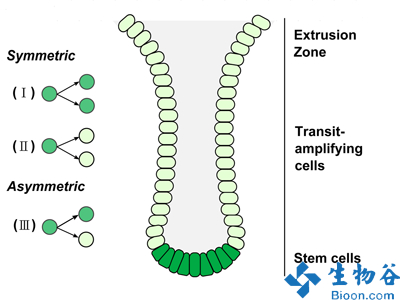Under the guidance of Dr. Zhai Weiwei and Professor Wu Zhongyi, the doctoral student Hu Zheng of the Beijing Institute of Genomics, Chinese Academy of Sciences, through the cooperation with Professor Yun-Xin Fu of the University of Texas in the United States, established the somatic cell traceability using the theory of population genetics The ancestral model (coalescent model) quantitatively describes the relationship between the different forms of stem cell division and the relationship between the ancestral relationship tree between the cells. For the first time, the study found that the intestinal epithelial adult stem cells of the mouse maintain the tissue balance of the division mode is an The characteristics of the gradual evolution of the stage, this is also the first time the vertebrate solid organization observed the above phenomenon. This finding is of great significance for studying the tissue balance of higher animals, including humans. The academic paper was published online in PLoS Genetics on February 28.
Adult stem cells, as a class of cells with specific differentiation potential, are widely present in various tissues and organs of multicellular organisms, and have the function of maintaining tissue balance and regeneration. In a stable environment, there are two ways for adult stem cells to maintain tissue balance: one is the asymmetric division method. Each time the stem cells divide, one daughter cell still maintains the stem cell state, while the other daughter cell enters the differentiation state. This way of maintaining balance is called the cell asymmetry mode; the other is the symmetrical division method. Each time the division occurs, the fate of the two progeny cells of the stem cell is the same, either stem cells or both Are differentiated cells. When the ratio of dividing into two differentiated cells is the same as the ratio of dividing into two stem cells, the number of stem cells in the population is still balanced. This way of maintaining balance is called a population asymmetry mode.

The picture shows the anatomical structure of the intestinal epithelium. Dark green represents stem cells, and light green represents transformed cells.
Previous studies have found that from invertebrates (including fruit flies, nematodes) to vertebrates (including mice and humans), the balance patterns adopted by different organizations have both a conservative aspect and a different aspect. Earlier studies found that most invertebrates use cell asymmetric patterns (for example, flies reproductive stem cells, neural stem cells), while vertebrate tissues tend to use population asymmetric patterns (eg, mouse intestinal epidermal stem cells, spermatogonial stem cells). These evidences generally come from experimental methods of lineage tracing. Due to the lack of robust specific adult stem cell markers, and the need to construct a targeted transgene recombination system and long-term tracing, this method has great limitations.
As a core branch of evolutionary biology, population genetics provides a lot of theoretical and methodological accumulation for studying the evolution of cell populations. In a cell population, the different division patterns of stem cells will have an important impact on the way the cell population is renewed, which in turn will produce different forms of ancestral relationships between cells. This ancestral relationship is very similar to the genealogical relationship of human populations.
Researchers at the Beijing Genomics Institute used single-cell sequencing data from intestinal epithelial cells of mice of different ages to analyze and infer through the ancestral model. The study found that the intestinal stem cells of young mice (52 days) mostly used the first cell asymmetric pattern, while the intestinal stem cells of adult mice (340 days) used the second group asymmetric method completely. The study found for the first time that the division pattern of adult stem cells to maintain tissue balance is a characteristic that gradually evolves with age (see figure). This is also the first time that vertebrate solid tissues have observed the above phenomenon, which is an update on the study of vertebrate tissues. It is very important. This research combines multiple disciplines including single-cell sequencing, developmental biology, and population genetics, and is an innovative attempt at the intersection of multiple disciplines.
This research was supported and funded by the Natural Science Foundation's major research project "Multigene Mechanism of Microevolution", the 973 Program of the Ministry of Science and Technology, and the Youth Innovation Promotion Association of the Chinese Academy of Sciences.
Stainless Steamer,All Clad Steamer,Steel Steamer,Stainless Steel Steamer Pot
Jiangmen T2grand Stainless Steel Kitchenware Factory , https://www.yapamit.com